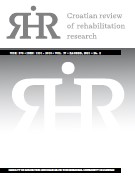EFFECTS OF VIRTUAL REALITY-BASED TREADMILL TRAINING ON BALANCE AND GAIT IN STROKE PATIENTS: A RANDOMIZED CONTROLLED TRIAL
EFFECTS OF VIRTUAL REALITY-BASED TREADMILL TRAINING ON BALANCE AND GAIT IN STROKE PATIENTS: A RANDOMIZED CONTROLLED TRIAL
Author(s): Maruša Kržišnik, Barbara Horvat Rauter, Nataša BizovičarSubject(s): Health and medicine and law, ICT Information and Communications Technologies
Published by: Sveučilište u Zagrebu, Edukacijsko-rehabilitacijski fakultet
Keywords: gait training; treadmill system; virtual reality; stroke;
Summary/Abstract: Gait and balance impairments contribute significantly to long-term disability after stroke. Modern concepts of stroke rehabilitation recommend a task-specific repetitive approach, such as using treadmill training. The purpose of this study was to investigate the effectiveness of using virtual reality-based treadmill training to improve balance and gait in subacute stroke patients. Twenty-two stroke patients were randomly stratified into two groups: the experimental (n = 11) and the control group (n = 11). Parameters associated with balance and gait were measured using the 6-minute walk test, the 10-meter walk test, the timed “up and go” test, the functional gait assessment, and the four square step test. Gait analysis using the zebris Rehawalk® treadmill system was also performed. Patients in the experimental group received virtual reality-based treadmill training five times a week for a period of four weeks, while those in the control group received treadmill training at the same frequency, duration, intensity, and structure, along with a progressively more difficult task demands. Significant improvements were observed in selected outcome measures in both groups after training. Patients in the experimental group experienced improvements in all of the spatiotemporal gait parameters, but there was a significant difference before and after training in duration of double support and lateral asymmetry. The findings of this pilot randomized controlled trial support the benefits of using a virtual reality-based treadmill training program to improve gait and balance in subacute stroke patients.
Journal: Hrvatska revija za rehabilitacijska istrazivanja
- Issue Year: 57/2021
- Issue No: 2
- Page Range: 92-102
- Page Count: 11
- Language: English

